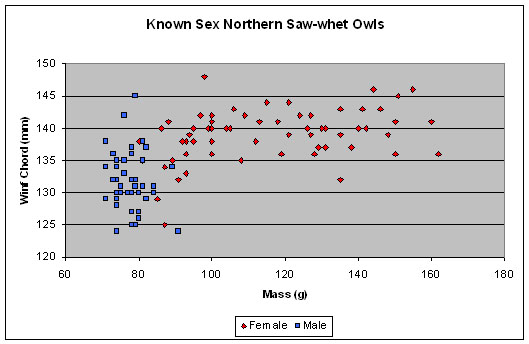Northern Saw-whet Owls exhibit moderate reverse sexual dimorphism by size, although an earlier published reference (Buckholtz et al. 1984, and Pyle 1997) using only wing chord does not accurately assign gender to many known-sex saw-whets, and should not be followed.
Instead, Project Owlnet and the U.S. Bird Banding Lab (BBL) recommend the use of sexing criteria developed by Brinker in 1997 that are based on a discriminate function analysis of mass and wing chord in >200 known-sex saw-whets. To download a copy of the sexing chart, click HERE.
The BBL and Canadian Wildlife Service CWS have approved the use of this method, although they require any bander using it to include the following remark on banding schedules: “Sex determined using the wing-mass DF available from Project Owlnet.”
NOTE: Proper gender assignment depends on accurate measurement of unflattened (natural) wing chord. The difference between wing chord and flattened wing is usually about 5mm, and may run to 8-10mm, so a poorly measured wing will significantly affect the accuracy of these criteria.
When sexing saw-whet owls, you should generally only need to use the table for owls with masses from 79-92g. Any owl with a mass of 93g or more is a female, and any owl with a mass of 78g or less is a male.

